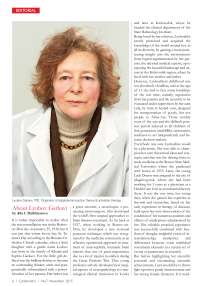About Lyubov Garkavi
Автор: Shikhlyarova Alla I.
Журнал: Cardiometry @cardiometry
Рубрика: Editorial
Статья в выпуске: 7, 2015 года.
Бесплатный доступ
ID: 148308810 Короткий адрес: https://sciup.org/148308810
Текст ред. заметки About Lyubov Garkavi
About Lyubov Garkavi by Alla I. Shikhlyarova
It is rather impossible to realize what the star constellation was in the Rostov-on-Don sky on January, 25, 1930, but it was just that winter frosty day, St. Tatiana's Day according to the Russian Orthodox Church calendar, when a little daughter with a gentle name Lyubov was born in the family of Khaim and Sophia Garkavi. For the little girl defined was the brilliant destiny to become an outstanding thinker, artist and poet, genetically substantiated with a powerful talent of her parents. Her father was a great scientist, a neurologist, a pioneering neurosurgeon, who developed the world's first surgical approaches to brain diseases treatment. As far back as 1927, when working in Rostov-on-Don, he developed a new cisternal puncture technique which was recognized by the medicine community as an effective operational approach in treatment of neurosyphilis, traumatic brain injuries that was of great importance due to a lot of injuries in soldiers during the Great Patriotic War. That young professor actively developed new surgical aspects of neuropathology at a neurological clinical institution in Gorky and later in Kislovodsk, where he headed the clinical department of the State Balneology Institute.
Being loved by her relatives, Lyubochka keenly perceived and acquired the knowledge of the world around her, in all its diversity, by gaining a more penetrating insight into the environment: from logical argumentation by her parents, the talented medical experts, up to enjoying the beautiful landscape and nature in the Kislovodsk region, where he lived with her mother and father.
However, Lyubochka’s childhood was not absolutely cloudless, and at the age of 11 she had to face some hardships of the war time, namely, separation from her parents and the necessity to be evacuated under supervision by her aunt Lida, by train in heated vans, designed for transportation of goods, but not people to Alma-Ata. Those terrible years of the war and the difficult postwar period induced in all children of that generation unchildlike seriousness, readiness to act independently and become decision-makers.
Everybody was sure Lyubochka would be a physician. She was able to champion her own theoretical ideas and concepts, and that was the driving force to study medicine at the Rostov State Medical University, where she graduated with honor in 1953. Later, the young Lady Doctor was assigned to the city of Magnitogorsk, where she had been working for 3 years as a physician at a Health Care Unit at an industrial factory there. It was the very time, her young days, when she gained her expertise as theorist and researcher, based on her early experience in therapy of diseases, built upon her own observations of the condition of her numerous patients and effects of medications administered by her. Her valuable practical experience was successfully combined with freedom of thought, insightful vision of interrelationship, similarities and differences between some individual constituent elements in a certain set of events or parameters in research.
But before highlighting her scientific potential and outstanding scientific achievements, I just would like to throw light upon her purely human nature and her strong female character. It is need- less to say that we do very much respect her as the originator of the classic activation therapy, but it should be noted that everyone was able to try how powerful her charm was.
Her slender figure and luxuriant bush
Lyubov Garkavi, a thoughtful scientist… disarming everybody with her charm.
of curly reddish hair did not leave any chance for other candidates at beauty contests which were held (even in those years !!!) among the girls in Rostov-on-Don. Her charming smile completed the impression, but her best, most perfect disarming tool was, of course, her intelligence, and no one could be compared with Lyubochka in this respect. Many admirers tried to win her favor, but it happened that she had only one loving man in her life for decades and that man did not become her husband. Every family according to her interpre- tation, as she remembered it from her childhood, should be consisting of mom, dad and children, but her fate was happily decided in the other way. Lyubochka wanted to have children, loved them, communicated openly with her friends’ and colleagues’ children and grandchildren and could easily speak a common language with them. Later, when her predestined global mission of the prominent researcher became clear, she offered a brilliant idea of the reaction of activation followed by her pioneering theory of the adaptational reactions in an organism, and she translated her personal human love into her own original discoveries treating them as “her children”.
But let us return to the chronology of the events: another very important key moment in the life of Lyubov Garkavi, namely, getting a job at the Rostov-on-Don Oncology Research Institute (RORI) in 1956, should be noted. The matter was that a year before, at RORI, by the Order of the Ministry of Health Care of the Russian Federation of the former Soviet Union, an experimental department, including a lab for pathophysiology, was established that was headed by Doctor of Medicine, Professor Maria Alexandrovna Ukolova. Afterwards, she became the Deputy Director of the said Research Institute and proposed a new research project "The role of neuroendocrine changes in tumor process". Taking into account the crucial role of the brain and its structures, particularly the hypothalamus, in the organism neuroendocrine regulation, the dissertation topics on "Impact of hypothalamic stimulation on the growth of inoculated sarcoma culture lines" were assigned to young researcher Lyubov Khaimovna Garkavi, who successfully defended her
PhD thesis 1962. Actually, it has become the starting point for Garkavi’s further profound research of laws and regularities of the organism reactions to external and internal stimuli, which were conducted using her original, most sophisticated pathological model of tumor growth. Upon 6 years of her deep analytical work, completed by passionate research talent of Lyubov Mikhailovna (L.H. Garkavi asked her colleagues to use such a patronymic), a great result, namely, an understanding of the mechanism of resistance of the
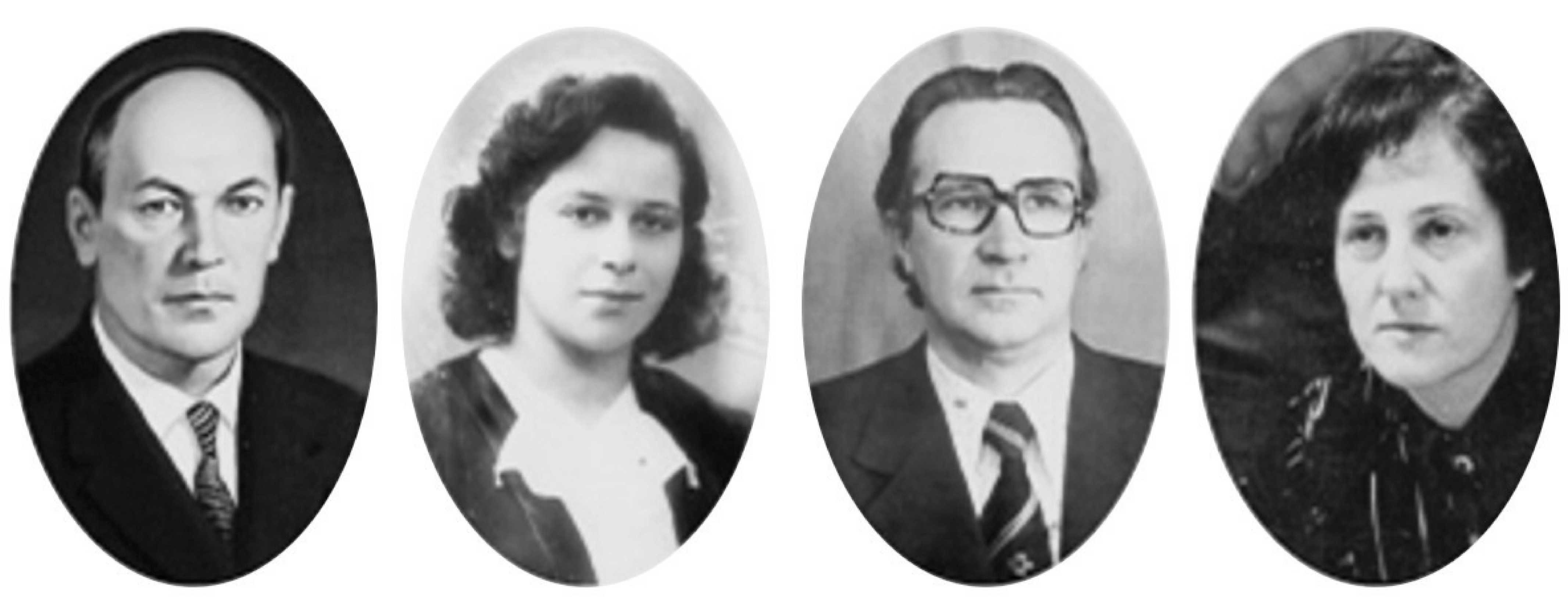
The powerful creative research team at RORI (from left to the right):
Mikhail M. Petyaev, Lyubov Kh. Garkavi, Jury N. Bordushkov, Elena B. Kvakina.
organism protection systems to tumor growth, was achieved. An original, strictly ordered logical concept of changes in developing general unspecific adaptational reaction, that Lyubov Mikhailovna called "activation", was completely described in her doctoral thesis "Adaptational reaction of activation and its role in the mechanism of anti-cancer effect of the hypothalamus stimulation" which was successfully defended in 1969. Her absolutely unique intuition and her unquestionable intelligence in developing fresh ideas of the existence of a previously unknown physiological groundwork for the organism anti-tumor resistance were the cornerstones in making her great scientific discovery we’ll discuss below.
The RORI leaders appreciated very much the great advance in Lyubov Mikhailovna’s scientific projects. Upon the reorganization of the experimental department, established were three independent research laboratories, and L.H. Garkavi headed one of them
(being responsible for development of new anti-tumor drugs and studies of drug effect mechanisms). The two other laboratories were responsible for cancer biophysics (headed by Prof. Petyaev M.M., later by Prof. Kvakina E.B.) and experimental hormone therapy of tumors (headed by Bor-dyushkova Y.N.). Thus, the former M.A. Ukolova’s small experimental department her students worked at, like a good fruit tree in a garden, producing a successful crop, has generated a lot of research ideas and developed strong branch structures for further scientific growth in studying hot topics in oncology and conceptual theory in medicine in general.
Lyubov Mikhailovna Garkavi’s research opened a new scientific field based on the discovery of " Pattern of development of qualitatively differing general unspecific adaptational reactions of the organism / Scientific Discovery Registration Certificate No. 158 issued by the Committee on Inventions and Discov- eries at the Council of Ministers of the
USSR, 1975). Her colleagues, companions and both friends E.B. Kvakina and M.A. Ukolova were among the co-authors of the discovery.
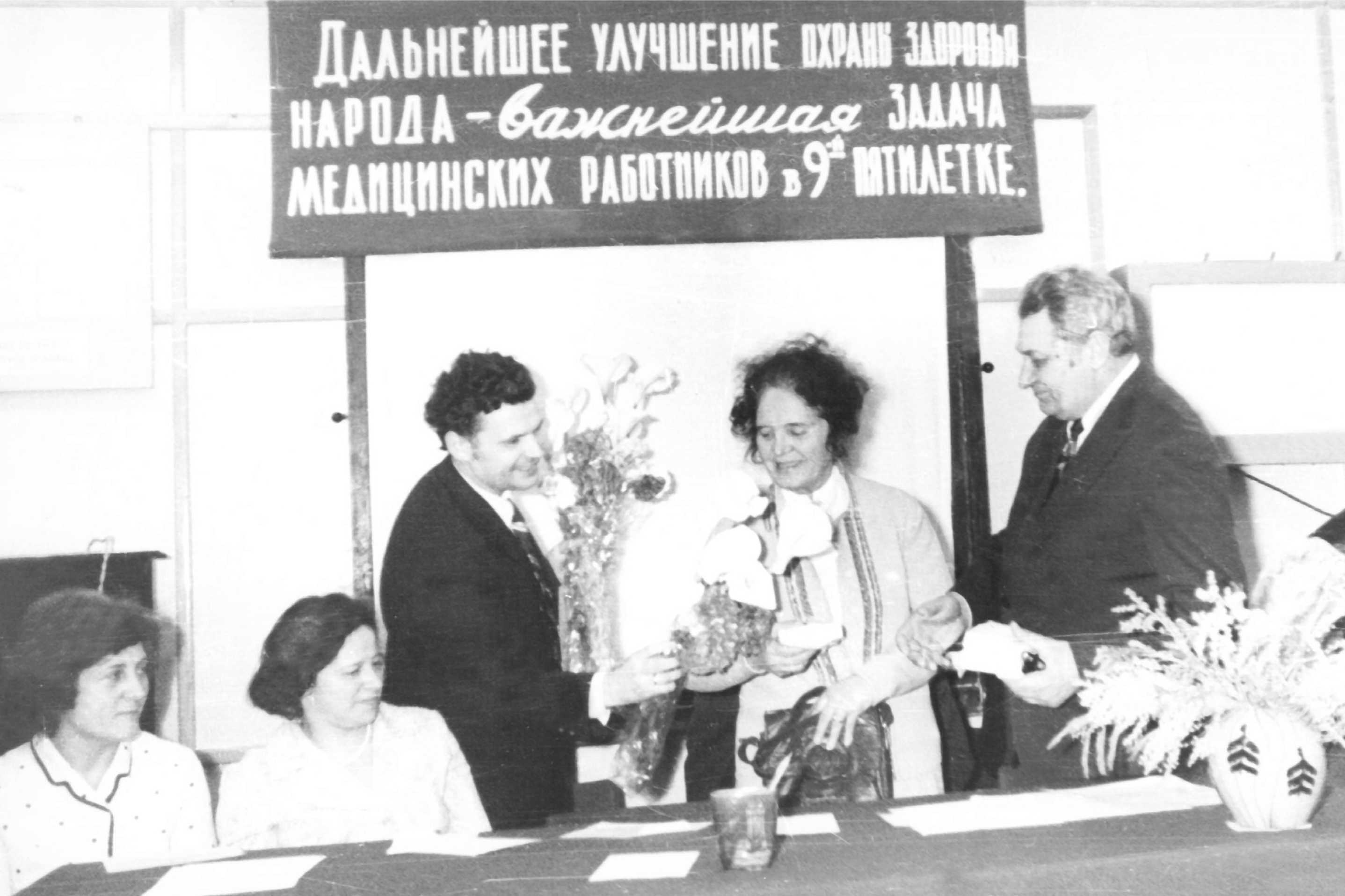
Ceremony of granting the Registration Certificate of Scientific Discovery “Pattern of development of qualitatively differing general unspecific adaptational reactions of the organism “ to Lyubov Garkavi (1976, Rostov-on-Don, Russia).
of these bright individualities has made a great contribution to the advancement of the discovery, which has become an important milestone in the development of the modern Russian national scientific school of physiology to continue the high scientific traditions of Pavlov, Sechenov, Speransky and other great scientists who worked in Russia.
The creative atmosphere at the RORI laboratories and an original interpreta- tion of the experiment results were favorable to opening a free way to the scientific discovery and developing the pioneering adaptational reaction theory.
A qualitatively new step in the theory advancement was the proper understanding of the periodicity and dependence of different adaptational reactions on the value (strength, dose) of a stimulus as an active factor in a wide range of intensities.
All those studies were highlighted in hundreds of scientific publications (more than 700), 3 editions of the monograph “Adaptational reactions and organism resistance”, 17 inventions and methodical recommendations. Lyubov Mikhailovna supervised more than a dozen of the dissertations, and she was a Member of the RORI Scientific Council and Ad Hoc Panel Committee. She was awarded with the Medal “For Valorous Labour”, the Badge of the Honoured Inventor of the USSR, High Achiever of Healthcare and the Order of Friendship.
Lyubov Mikhailovna was not only an outstanding scientist. Her talent was like a diamond with many fine facets maximizing brilliance and sparkle. The pictures painted by her on the shore of the river Don or at the Azov Sea, in a park or at home, when looking at the bunch of lilies or lilacs, are full of love to life and nature. She created more than 60 pictures of small and large format, reflecting not only her view, but also an impression that passed through her great, world-loving soul. The same feeling comes, when reading her poems. In a small collection of poems called "In my soul ..." captured are the real bright moments of her life, human relations, sketches on the beauty of na- ture and some philosophical reflections. These poems were as easy as her breathing was, as her light steps were or as ripples of her laughter were.
We ought to give thanks for all fortune because we enjoyed the opportunity to communicate, to be trained by and simply live for many years with such a beautiful creation of God, whose name is Lyubov! We are lucky people to have had the honor to work under the gentle supervision by the great scientist, the thinker, the fine creative nature and extremely wise woman, whose name was Lyubov Mikhailovna Garkavi.
We would be grateful to readers if they would accept our essay which is rather of emotional nature and cannot be treated as a scientific report. But our intention is to represent to you the live rhythm of her heart, mind and life.
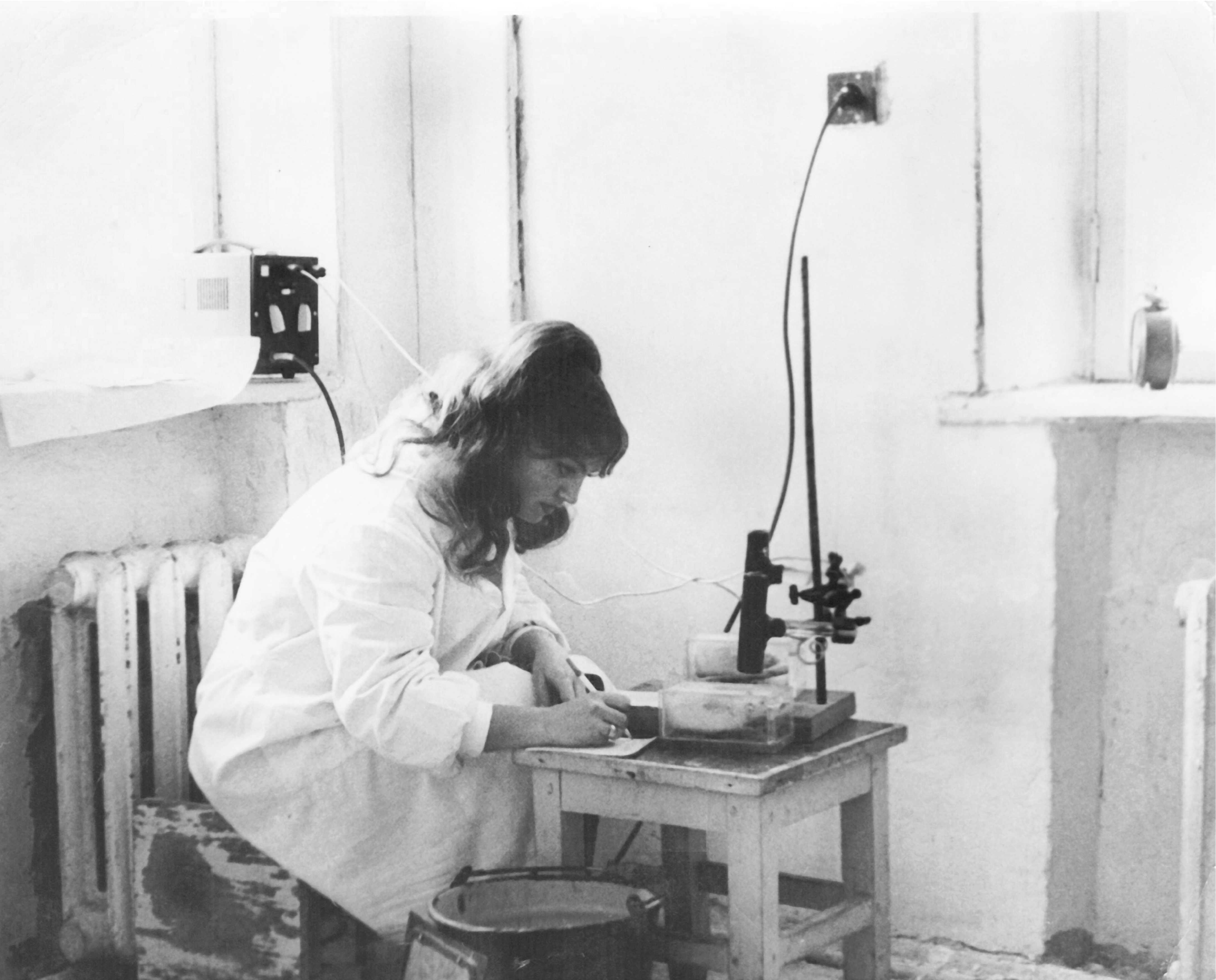
At the cradle of the great science: activation therapy. Alla Shikhlyarova is conducting blood count in rats to determine the types of adaptational reactions. A standard set of lab equipment at that time: a conventional microscope, a clock, a bucket and a simple seat. The 70s, Rostov-on-Don, Russia.
Going back into the 1970s
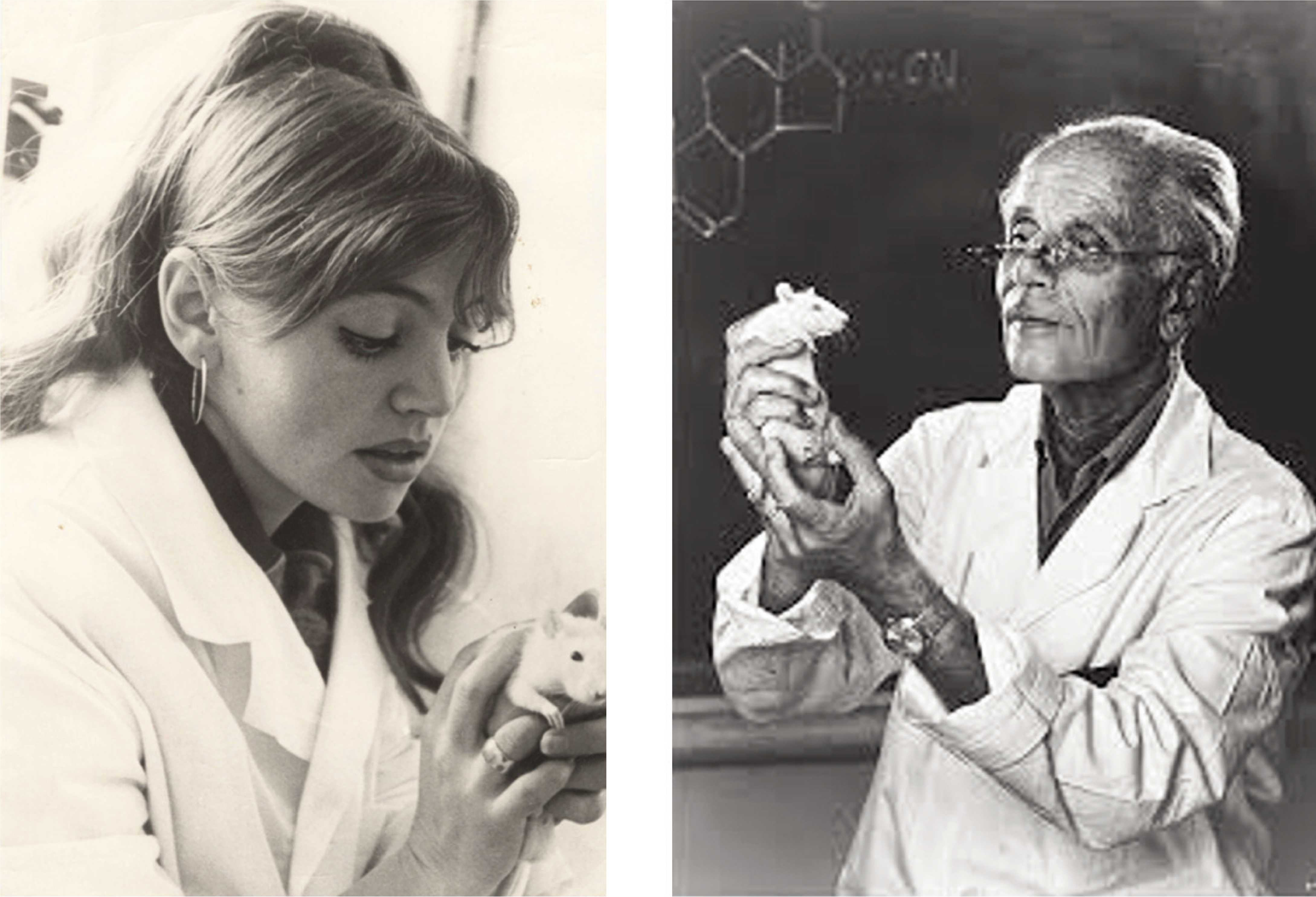
Alla I. Shikhlyarova in Rostov-on-Don, Russia. Hans Selye in Montreal, Canada.

